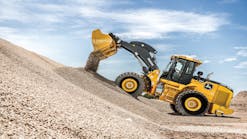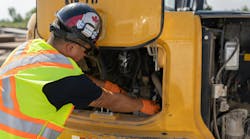By Kris Troppmann
Photos by Finning Canada
There is a lot of discussion going on around the future of construction and where the industry is headed. Labor continues to be in short supply and the recent COVID-19 pandemic has only intensified the level of project uncertainty and added pressure on companies with additional guidelines to keep employees safe. Add the fact that hundreds of thousands of workers are due to retire in the next decade and you have an even greater workforce shortage on your hands. The obvious solution is to recruit the younger generation. But to do this, young people have to see the value of a career in construction.
Physical labor will always be at the core of the construction industry. But it’s not all about getting dirty, digging holes and working in remote locations anymore. That’s why changing the perspective of the younger generation is quickly becoming a top priority. Technology is providing opportunities to attract new workers and will play a big role in bridging the labor gap. But even with a possible big construction infrastructure spend in the next few years, is the industry doing enough to support the workforce of the future?
Time to re-think training and recruitment
For millennials, who have grown up with technology, a move toward a more digital industry presents a golden opportunity. Technology has shaped their entire lives; they tend to understand how it works and its capacity to get the job done faster and more efficiently.
A giant shift in thinking is needed by the construction industry as a whole. Technology is moving at a rapid pace, but it needs workers to support it. Reaching the younger generation on the breadth of career opportunities available in the industry is one of the biggest challenges this industry faces. Training, apprenticeship and recruitment strategies all need to change. Job postings and apprenticeships need to focus more on the technological skills required for a career in construction. Options for digital learning, virtual reality and remote training can help support on-the-job training and tools like social media and influencers can help companies connect with the younger generation.
Contractors will continue to struggle to keep jobsites fully staffed. Tools like social media are helping not only with recruitment but building awareness – companies now leverage Facebook, YouTube and Instagram to tell stories, profile workers, share photos and videos of a very different job site. Social media can also be used to promote a technology-savvy workplace, and feature career advancement opportunities to show potential employees what it would be like to work in the industry today.
Using technology to do more with less
The recent pandemic has resulted in a lot of challenges -- projects on hold, an increased focus on worker safety and gaining access to job sites to name a few. But it has also shined a light on many opportunities. Companies are beginning to understand that without the right technology it can be difficult to access the up-to-date data needed to make informed decisions. And command centers are offering workers an alternative to working on a remote job site. Technology is fast becoming an indispensable part of each and every job function, successfully improving the efficiency, speed and accuracy of a construction operation.
From drones, telematics, 3D machine control, automation, safety technology and artificial intelligence - the same technology tools that are helping companies keep costs down, operate more effectively and gain an advantage over the competition, can also help make the industry more attractive to the younger generation.
Telematics, used on many jobsites today, can help predict upcoming equipment failures, keep track of maintenance schedules, records, inventory and parts, site surveying and the maintenance and ongoing management of equipment. But it also provides a huge appeal to millennials. Equipment features like touch screens, quiet, comfortable, climate-controlled cabs, with enhanced visibility, outfitted with Bluetooth and the latest technology make the operator experience even more appealing. From a site manager perspective, these technologies can also help prohibit bad habits like speeding, excessive idling and overloading, which leads to increased safety on the jobsite, reduced wear and tear on the machine and increased efficiencies. Global Navigation Satellite System (GNSS) and machine control allows inexperienced operators to effectively operate equipment with a minimum level of instruction. They can also facilitate two-way teaching. Less experienced operators can teach more experienced operators how to use the technology to be more efficient, allowing the more experienced operators time to train new operators on the nuances of general machine operation.
Prioritizing safety
There has been a shift away from the long hours and a finish-at-any-cost mentality on construction sites, and it has resulted in overall improved safety in the industry. Companies are much more vested in their employees’ well-being, which in turn is helping to attract a younger and more diverse workforce. Technology has played a huge role in this shift.
Wearables to keep workers safe, smart cameras mounted on equipment to help prevent accidents and improve visibility, advancements in machine control and command centers where machines can be operated remotely are all allowing for operators of all abilities, experience and skills to quickly learn to operate the equipment safely and efficiently and be more productive.
Another example of technology enhancing safety is through the increased use of drones. They can be used for a range of surveying functions on a job site. A drone in flight can identify what parts of the site need to be filled and moved very quickly, and this data can then be uploaded directly into the machine, increasing accuracy and reducing the amount of manual work for the surveyor, making for a safer work environment.
Transforming the industry
When the topic of technology comes up, often we hear comments about it replacing workers. Technological advancements in construction are undoubtedly moving at a fast pace, and greater automation and increased use of AI are in our future. But there will always be a need for humans; it’s the nature of the work that will change.
The time has come for companies to step up and adopt technology to help make jobsites safer, replace high-risk work, reduce intensive manual labor and fill gaps in the existing and future workforce with new talent. When companies make the decision to embrace technology, they need to build a culture to support it -- and invest in new ways to attract a younger generation to the industry. This will ensure that they will have the workers they need and be better prepared to compete in the long run.
_____
Kris Troppmann is regional technology manager, Finning Canada








